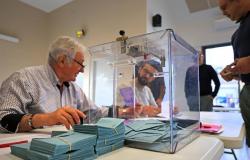Eighty years ago, two events of the liberation of France occurred within a few days of each other in the Mélusin region. The first, joyful and full of hope, was, on the night of June 11-12, 1944, the liberation by the FTPF resistance fighters of the Rouillé internment camp.
This camp, opened by the Vichy authorities and hypocritically called the “Surveillance Center”, welcomed the “undesirables” of the regime: communists in the first place but also Jews, Spanish republicans, plus a few Russians, Armenians, etc.
Released then shot
For many, this camp was only a step on the path to deportation. Others managed to escape and join the ranks of the Resistance. This is also what many of those released in June 44 did.
Some of those who joined the Resistance will be among the victims of the second event, a tragic one, commemorated this weekend: the Vauleton massacre which saw 31 captured resistance fighters murdered by the Germans.
The comic strip of two high school girls
Saturday June 29, 2024, at the Rouillé village hall where a World War II history book fair is being held, the heroes of the Rouillé camp were honored.
President of the Association for the Memory of the Resistance (Amrid 86), Jean-Jacques Guérin first presented the comic strip I will marry my little postman. This work tells the story of the Rouillé camp through the love story between Jean Fumoleau, a communist resistance fighter interned at the camp, and Simone Lombard, who delivered food and mail to the prisoners. It was produced by two high school students from Bois-d’Amour, in Poitiers: Zoé Baudoin and Sabine, aka Justin Trognon.
In Celle-Lévescault, one of the names of those shot is false!
This work was rewarded by the National Competition of Resistance and Deportation which decided to have it published.
Simone was one of those courageous emissaries who defied controls to bring prohibited goods into the camp. The most famous of them was a nun, Sister Jeanne Chérer, whose cornette and knowledge of German served as a gateway to come and go in the camp.
A communist nurse
On Saturday, historian Jean-Marie Augustin retraced the history of this heroine, to whom Lusignan is also paying tribute this Sunday.
Sometimes, the few people allowed to go behind the barbed wire managed to get a detainee out. This is what happened to Paul Thomoux. This Parisian trade unionist, psychiatric nurse and communist, had been interned at Rouillé where he became the assistant of Doctor Cheminée, himself a resistance fighter.
Hospitalized at the doctor’s request, Paul Thomoux managed to escape and joined the Saint-Sauvant maquis. Having participated in the liberation of the camp, Paul Thomoux was to be one of the 31 shot at Vauleton.
“It was only several months later that my grandmother was able to identify her husband’s body. The Germans had driven over the bodies of those shot in trucks and scattered their remains in the cemeteries of the surrounding towns,” says Sylvie Ducretot, Paul’s granddaughter, who has just published a book recounting the life of her resistant grandparents.
Santiago was not dead
With these ceremonies, Amrid once again serves the memory of the dark hours of the war. A work that is never finished and that sometimes holds surprises, such as the one mentioned on Saturday by Jean-Jacques Guérin: among the 31 dead whose name is on the Celle-Lévescault monument is that of a certain Santiago Marruedo-Fraile.
However, this Spanish republican, freed from Rouillé on June 11, although he indeed joined the Resistance, was never shot: we find traces of it in Nantes in… 1976! We have recently learned that 30 identified resistance fighters and one unknown person were murdered in Vauleton.
The ceremonies of Sunday June 30
> 9 a.m. in LusignanPlace de la Mairie, tribute to Sister Jeanne Chéré.
> 10 a.m. in Celle-l’ÉvescaultVaugeton monument, homage to the martyrs of the Saint-Sauvant forest.
> 11 a.m. in Rouillé, Place du 8-May-1945, tribute to the internees, shot and deported at the camp stele.






